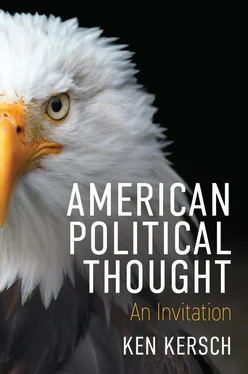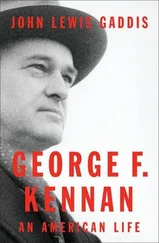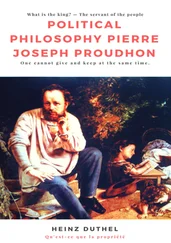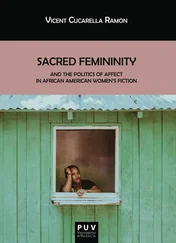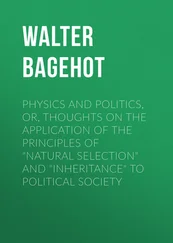Framing and Ratifying the Constitution: “The Great National Discussion”
As he would later emphasize in The Federalist , a series of newspaper articles advocating ratification of the Constitution that he co-authored with James Madison and John Jay under the pseudonym Publius, Alexander Hamilton understood the chief problem under the Articles to be inadequate “energy” in the national government. George Washington concurred in the view that effective governments are possessed of adequate power to sanction, coerce, and enforce to secure the common good, and that the proposed Constitution provided the framework for such a government.
Convinced that the country had entered a “critical period” in which its survival was at stake, fifty-five delegates from every state save Rhode Island met in closed-door session in Philadelphia from May to September 1787, with George Washington presiding – silent until the end – and James Madison, Gouverneur Morris, and James Wilson driving much of the discussion. The convention lost a few delegates along the way, a number of whom, fired by the republicanism that had informed the Articles of Confederation, smelled a rat.
The challenge was to devise a popular government that would remain true to its core principles while proving institutionally effective and sustaining popular support. James Madison and Edmund Randolph seized the initiative – illegally, given the limited mandate of the convention – to propose an entirely new framework of national government. They proposed the creation of a national executive (the President) and a federal judiciary, as well as a legislature, the Congress, directly elected by the people according to population, with real powers to levy taxes and establish an army. In addition, they expressly proposed that appropriately authorized national laws would take precedence over those of the states. A challenge to this “Virginia” (or “Large States”) plan was mounted by the less populous states (the “New Jersey Plan,” spearheaded by William Paterson), which called, among other things, for the retention of the unicameral legislature of the Articles of Confederation, with one vote per state. The proposed institutions of the new government were discussed and debated at great length at the Philadelphia Convention, some, to be sure, more extensively than others. (The deeply divisive subject of chattel slavery was barely discussed, though it was clearly understood that guarantees for its continuation in pro-slavery states had to be scrupulously provided.) In the end, a Great (or “Connecticut”) Compromise, brokered by Roger Sherman and Oliver Ellsworth, divided the Congress into an upper and lower house, with the former comprised of two representatives from each state, elected by the legislatures of those states, and the latter directly elected by the people on the basis of population.
Departing from the design of the Articles, the proposed Constitution’s Preamble announced that “We the people” (not “We the undersigned delegates of the states”) were promulgating the country’s fundamental law. Citizens were represented directly in the House of Representatives rather than through the intermediary of their state governments. They were taxed directly as well, giving the national government the wherewithal to act and spend without applying cap-in-hand for requisitions from the states. There was provision for a strong, independent executive, and a potentially powerful federal judiciary. Of those delegates who remained for the duration of the constitutional convention, the product of these sustained deliberations won overwhelming, though not unanimous, support.
The men who gathered at Philadelphia to frame the new Constitution were an elite and learned lot who had undertaken additional studies in both ancient and modern history and political theory to inform their momentous deliberations. They would draw on this political science extensively in explaining and justifying their handiwork to what, they knew, might be a skeptical and divided polity. Convincing arguments mattered. But those supporting ratification put their thumbs on the scale. While maintaining the “one state, one vote” principle of the Articles, they altered the unanimity requirement by providing for ratification by nine of the thirteen states. They circumvented entrenched interests in the state legislatures while taking care to avoid creating new rival power centers by allowing (temporary) state ratifying conventions. This, moreover, would lend the new Constitution “downstream legitimacy” by providing for ratification by the people themselves. They would be temporarily mobilized to directly exercise their sovereign authority in a moment of high importance that Alexander Hamilton, among others, suggested would do nothing less than decide the fate of all mankind, and then be immediately shuffled off the national stage. 4
We are now one nation of brethren. We must bury all local interests & distinctions…. No sooner were the State Governments formed than their jealousy and ambition began to display themselves. Each endeavored to cut a slice from the common loaf, to add to its own morsel, till at length the confederation became frittered down to the impotent condition in which it now stands…. To correct its vices is the business of this convention.
James Wilson (1787)
The lesson learned during the 1780s by those who supported the ratification of the new Constitution – the Federalists (a name advisedly chosen to avoid the scare-mongering labels “nationalists” or “consolidators”) – was that the country needed a more powerful centralized government than the Articles of Confederation allowed, and a more competent, virtuous, and responsible leadership than the locals had chosen in the states. There was agreement on this – in theory at least – between, on the one hand, Federalist supporters of the 1787 Constitution like John Adams, James Madison, Alexander Hamilton, and George Washington and, on the other, Antifederalist opponents like Samuel Adams, Richard Henry Lee, George Mason, and Patrick Henry. They had radically different concerns, however, about the proffered solutions.
The Federalists argued that the new Constitution achieved the necessary vigor and competence at the national level while simultaneously, and ingeniously, providing for popular rule and protecting the fundamental rights whose violation had occasioned the American Revolution. The Antifederalists, by contrast, were convinced that the new Constitution would lead to the ultimate evisceration of the rights the American revolutionaries had fought to preserve, through the (re)creation of a distant, overly centralized government, and a dangerously empowered elite, who would institute despotic, quasi-monarchial rule under new auspices. The battle was hard-fought: the future of liberty, and the survival of the nation, many believed, was at stake.
Alexander Hamilton and James Madison were the pre-eminent proponents of the new Constitution. Hamilton, a fiercely intelligent and peerlessly ambitious Caribbean immigrant of obscure origins, was the chief proponent of the creation of a strong, active national government both as a solution to the country’s current problems and as a foundation for the nation’s future glory as one of the world’s most powerful, eminent, and prosperous states – the equal, if not the better, of Great Britain or France. The young Hamilton, a financial genius, had penned brilliant pamphlets in support of the Revolution, and quickly came to the attention of the head of the revolutionary army, George Washington, with whom he became an aide-de-camp and an unusually close confidant. Hamilton spearheaded, and was the most prolific author of, The Federalist , a series of eighty-five essays published in the New York Independent Journal which his future rival, Thomas Jefferson, called “the best commentary on the principles of government which ever were written.” The Federalist essays struck “Hamiltonian” themes, such as a reiteration of the surpassing need for “energy” in government: that is, the idea that the national government should have power to act quickly, decisively, and effectively in carrying out its responsibilities. Hamilton insisted that, as the country’s travails under the Articles had made all too clear, the revolutionary era opposition between liberty and authority had to be rethought. The order and stability that a well-framed, energetic government could provide were not inherently a threat to liberty and justice but, ultimately, their guarantor. An appropriately empowered and effective national government, Hamilton argued, was worthy of the respect and esteem of all true republicans.
Читать дальше
